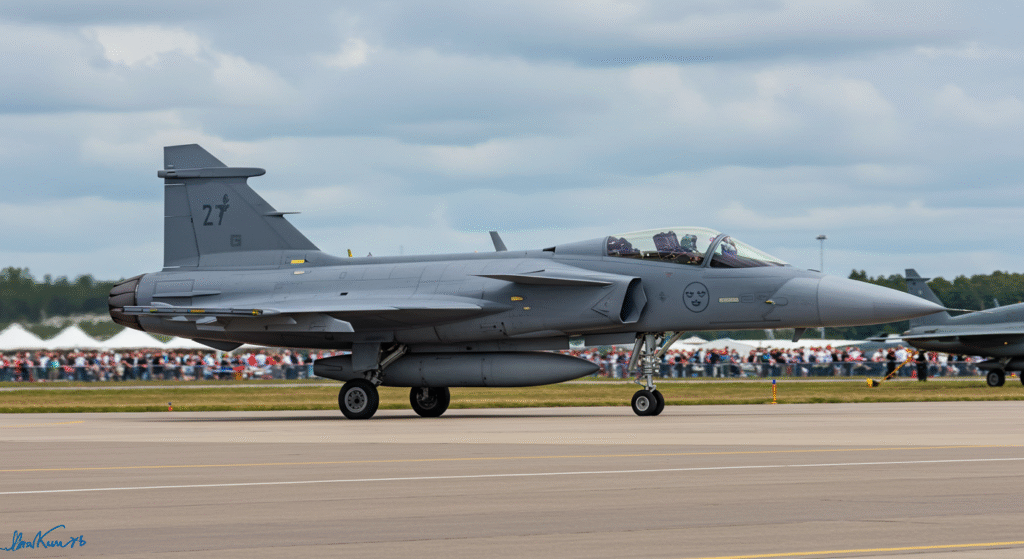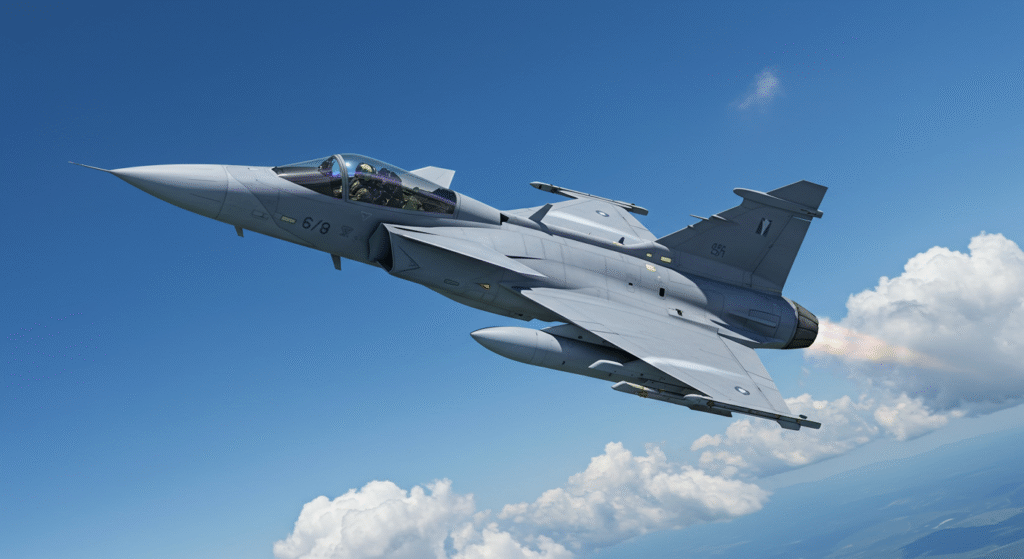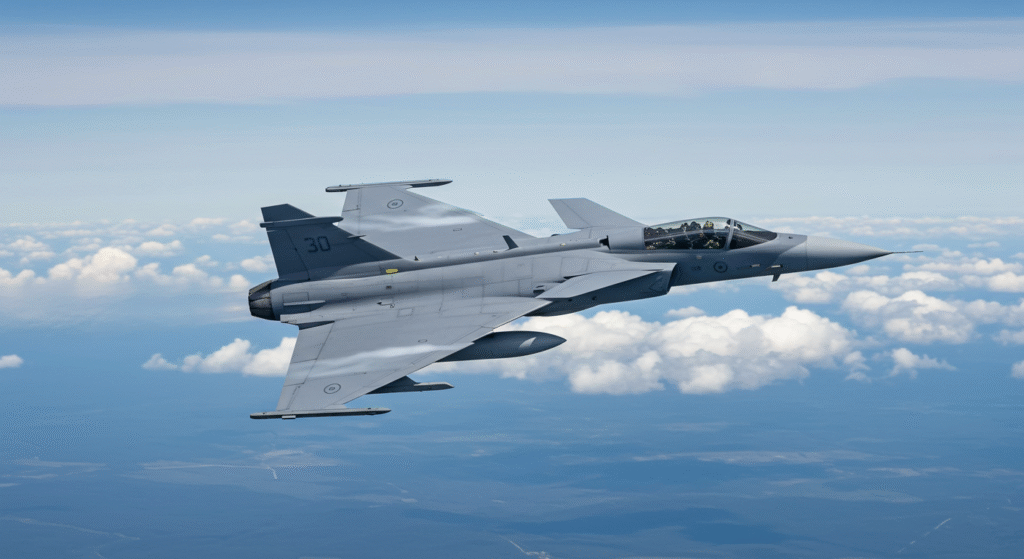Discover the remarkable journey of the Gripen C/D in “The Global Griffin Takes Flight.” Explore its design, capabilities, and impact on modern aviation.
Following the pioneering spirit of the Gripen A/B, which laid the crucial groundwork for Saab’s vision of a cost-effective, multirole fighter, came the natural evolution: the Gripen C/D. This series, comprising the single-seat JAS 39C and the two-seat JAS 39D, didn’t just build upon its predecessor; it refined, modernized, and ultimately propelled the Gripen onto the international stage. The C/D variants transformed the Gripen from a formidable national defense asset into a globally competitive fighter, ready for the complexities of modern coalition warfare.
Stepping Onto the Global Stage: NATO Interoperability
The Gripen A/B proved the fundamental concept of a highly capable, cost-efficient multirole fighter. However, as the geopolitical landscape shifted post-Cold War, the need for international cooperation and interoperability became paramount. For countries looking to join organizations like NATO or participate in multinational operations, their military hardware needed to seamlessly integrate with allied forces. This became a key driver for the development of the Gripen C/D.
Meeting International Standards
The C/D series was specifically designed to meet and exceed these international interoperability requirements. This meant significant upgrades to communications, navigation, identification (IFF – Identification Friend or Foe) systems, and data links. The goal was to ensure that a Gripen C/D could operate effectively alongside F-16s, Eurofighters, and other advanced Western fighters, sharing tactical information and coordinating missions with ease.
In-Flight Refueling Capability
One of the most significant external changes was the introduction of an in-flight refueling probe. While the Gripen A/B was designed for dispersed operations from short runways, limiting its range was an acceptable trade-off for Sweden’s domestic defense needs. For international deployments, however, extended range and endurance were crucial. The refueling probe transformed the Gripen’s operational reach, allowing it to undertake longer missions, project power further from its bases, and integrate into air-to-air refueling plans with allied tanker aircraft. This single addition dramatically increased the aircraft’s tactical flexibility.
Enhanced Systems: The Brains Behind the Brawn
Beyond external modifications, the Gripen C/D received a substantial overhaul of its internal systems, significantly boosting its combat capabilities.

Improved Avionics and Software
The C/D variants benefited from more powerful mission computers and updated software. This allowed for greater data processing capabilities, enabling more sophisticated sensor fusion – the ability to combine information from various onboard sensors (radar, IRST, EW suite) into a single, coherent tactical picture for the pilot. This enhanced situational awareness was a critical advantage in dynamic air combat environments.

Integration of Advanced Weaponry
The Gripen C/D was designed to carry a wider and more advanced array of weaponry compared to its predecessors. This included:
- Beyond Visual Range (BVR) Missiles: Integration of missiles like the AIM-120 AMRAAM (Advanced Medium-Range Air-to-Air Missile) gave the Gripen the ability to engage enemy aircraft at long distances, a crucial capability in modern air combat.
- Precision-Guided Munitions (PGMs): For its attack role, the C/D could deploy various PGMs, including laser-guided bombs and GPS-guided munitions, enabling precision strikes against ground targets with reduced collateral damage.
- Advanced Reconnaissance Pods: For its “Spaning” (reconnaissance) role, the C/D could carry more capable external reconnaissance pods, providing high-resolution imagery and electronic intelligence gathering.
Cockpit Evolution
While maintaining the excellent ergonomic principles of the A/B series, the C/D cockpit saw further refinements. Enhanced Multi-Function Displays (MFDs) with better graphics and processing power, along with updated Human-Machine Interface (HMI) software, made the pilot’s job even more efficient. The Hands-On Throttle And Stick (HOTAS) concept remained central, ensuring critical functions were always at the pilot’s fingertips.

The RM12 Engine: A Trusted Workhorse
The Gripen C/D continued to utilize the robust and reliable Volvo Aero RM12 engine. While the C/D’s airframe and systems had evolved, the engine proved capable of handling the increased demands, delivering consistent performance and maintaining the Gripen’s reputation for low operational costs and high dispatch rates. The RM12’s proven track record contributed significantly to the Gripen C/D’s attractiveness to international buyers.
International Success and Operational Deployment
The Gripen C/D series truly made the Gripen an international success story.
Export Orders
The Czech Republic and Hungary became the first export customers, leasing Gripen C/D aircraft from Sweden, primarily for air policing missions within NATO. This was followed by outright purchases by South Africa and Thailand. These nations valued the Gripen’s blend of advanced capabilities, low operating costs, and adaptability to various operational scenarios. The Gripen C/D’s entry into service with these air forces demonstrated its versatility and ability to perform effectively in diverse climates and operational doctrines.
Operational History
The Gripen C/D’s operational history has been rich with international exercises and air policing duties, showcasing its interoperability and effectiveness alongside allied aircraft. It has participated in numerous NATO missions, including Baltic Air Policing, demonstrating its readiness and capability to contribute to collective defense. While known for its excellent training and deterrence capabilities, its first combat deployment occurred in July 2025, when the Royal Thai Air Force used its Gripen C/D fighters in a targeted strike against artillery positions on the Cambodia-Thailand border. This marked a significant moment for the platform, proving its effectiveness in a live combat scenario.
A Legacy of Adaptation
The Gripen C/D represents a pivotal chapter in the Gripen’s history. It transformed a clever national solution into a global contender, demonstrating Saab’s ability to adapt its core design to meet evolving international requirements. It validated the Gripen concept on a much larger scale, paving the way for the next generation of Gripen E/F and solidifying its place as a formidable and highly respected multirole fighter in the 21st century.

